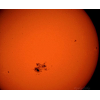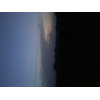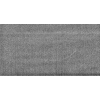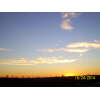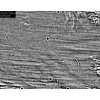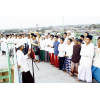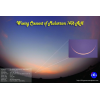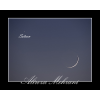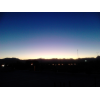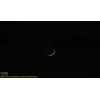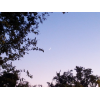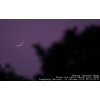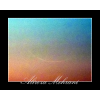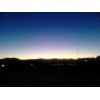Visibility of Muharram Crescent 1436 AH
- When to Observe Muharram Waxing (NEW) Crescent ?
- Muharram Waxing (NEW) Crescent Observation Results
- The OFFICIAL First Day in Different Countries
- When to Observe Dhul Hijjah Waning (OLD) Crescent ?
- Dhul Hijjah Waning (OLD) Crescent Observation Results
When to Observe Muharram Waxing (NEW) Crescent ?
The geocentric conjunction (Geocentric New Moon) will occur Inshalla on (Thursday 23 October 2014) at 21:57 UT.
Sighting the new crescent on (Thursday 23 October 2014) and (Friday 24 October 2014) is shown in the below graphs using the program Accurate Times by Mohammad Odeh according to Odeh criterion. Where:-
- It is impossible to see the crescent from the areas located under the red color. Because either the Moon on this day sets before the Sunset and/or the topocentric conjunction occurs after the Sunset.
- The crescent is expected to be seen by optical aid only from the areas located under the blue color.
- The crescent is expected to be seen by optical aid from the areas located under the magenta color. In these areas the crescent could be seen by naked eye if the atmospheric conditions are superb and the observer is experienced.
- The crescent is expected to be easily visible by naked eye from the areas located under the green color.
- The crescent cannot be seen from uncolored areas, even though the Moon sets in these locations after the Sunset and the topocentric conjunction occurs before the Sunset, but the Moon is not sufficiently illuminated in order to be seen as crescent even by optical aid.
- Kindly notice that the below graph shows the possibility of seeing the crescent from areas between 60 degrees north of Equator down to 60 degrees south of Equator.


According to the Universal Hejric Calendar (UHC), which is based on the calculated crescent visibility, the start of this month in the Eastern Region will be on Saturday 25 October 2014 and in the Western Region will be on Saturday 25 October 2014. Kindly notice that the UHC is a pre-calculated calendar, which adopts a certain criterion to start the new Hejric month. Your country/organization might adopt different criterion to start the new Hejric month. So it is highly advised to read the UHC website before giving any judgment.
- Results of seeing the crescent, and the first day of the month in different countries will be added here Inshalla as we receive the reports from ICOP's members. If you wish to be a member in ICOP, or to know more about it, kindly click here.
Muharram Waxing (NEW) Crescent Observation Results
Thu 23 October 2014
Libya
Fri 24 October 2014
Australia
Ghana
Mr. Baba Abdulai said: "I was at the sighting post from about 17:50 to about 18:30 but I did not see the crescent. The sky was quite clear with almost no clouds. Sighting community; Kukuo Yepalsi, near By-Water reservoir, Tamale."
Indonesia
Mr. AR Sugeng Riyadi said: "On Friday, 24th October, 2014, we were about 80 students from CASA (Club Astronomi Santri Assalaam) Surakarta Indonesia tried to see the crescent of Muharram 1436 AH at Assalaam Observatory at 5.00 pm to 6.00 pm. The new crescent of Muharram 1436 AH was NOT SEEN. Western horizon sky was partly cloudy. "
Iran
Mr. Hossein Janghorbani said: "In the name of God Muharram Crescent Observation Report Astronomy and Geophysics Center of Shahreza – The Crescent Association of Shahreza Report by: Hossein Janghorbani (Najm-al-Sepehr) – Manager of Shahreza Crescent Association and Red Crescent’s Astronomy and Geophysics Center Date: Friday, 10/24/2014 Location: 40 kilometers far from shahreza to Semirom called khorusgelu (latitude: 31° 38' N, longitude: 51° 42' E, elevation: 2581 m from sea level, time zone: +3.5 GMT) Equipments: one set of 15*70, three sets of 20*90 binoculars, one compass. Atmospheric condition: hazy in western horizon. Horizon obstacles: about 0.5° Apparent sunset: 17:19 Apparent Moonset:-- Results: Moon crescent was not seen because was hazy in western horizon. Observers: 1-Sayed Farzad Alavi 2.Mahdi Ghasemi 3. Ali Rastegari 4. Mohammad Javad Nikeghbal 5. Hossein Janghorbani 6. Ali Janghorbani 7.Reza Janghorbani 8. Narjes Zare 9. Zinat Ghermezi 10. Roya Ghermezi 11. Zahra Parsania 12. Tayebeh Shafiee 13.Talaat Taheri 14.Reyhaneh Dadvand 15.Mahsa Khajeh 16.Zahra Farokhpoor 17. Zahra Fallahi " "
Malaysia
Nigeria
Mr. Yunusa Yakubu said: "We were at the sighting venue 25 min to the sunset at 17:44 the sun set behind cloud at 18:03 the Moon was not sighted and at best time 18:20 the moon was not sighted see attached pictures. I have make inquiries from neighboring Plateu State, Gombe, Kaduna and Zamfara States all no Positive sighting report. However, Some broadcasting stations announced today to be 1st Muharram while a source from the Sultanate says tomorrow 25/10/2014 was declared 1st al-Muharram."
Dr. Z.Sani Mustapha said: "By Hisaab the moon cannot be sighted by the naked eye today in my zone. "
Oman
Prof. Mohammed Al-Bussaidi said: "The crescent Moon was sighted for few minutes after sunset as they was clouds at the western horizon where the Sun is setting."
Saudi Arabia
Eng. Qamar Uddin said: "On Friday 24th October 2014, I joined a local group of observers from Dammam and tried to sight the crescent moon (Hilal) of Muharram 1436 AH from the outskirt of the city with a clear field of view to the horizon. The western horizon was hazy and so we could not see the moon by naked eye, binoculars or even with telescope. The Meade LX200 telescope was being driven by a computer and it was able to slew to Saturn very accurately as we were able to see the rings very clearly in the telescope eyepiece. The attached photo of the Saturn was taken about 20 minutes after sunset (but before moonset) with a mobile phone."
Dr. Ayyub Patel said: "The sky was very clear but on the western horizon where sun set there were a few thick clouds. The Muharram hilal was not seen although this was the 30th day of Dhul Hijjah according to Ummul Qura calendar and according to Saudi sighting claimed month. Today the moons age was some 16 hours and sunset moonset gap was around 20 min. When even on the 30th day there is no general public sighting, it clearly puts into doubt that the start was declared wrongly based on very doubtful if not false sighting."
South Africa
United States
Dr. Javad Torabinejad said: "I arrived at my sighting location (The Blacksburg Middle School) at 6:00 pm EDT (sunset: 6:32 pm). Later my daughter and her friend joined me. Using binoculars (7X50 and 10X50), I scanned the mostly clear but hazy WSW horizon. My first binocular sighting was at 6:58 pm. Soon after, my daughter and her friend also sighted the crescent using the 10X50 pair of binoculars. For a few minutes starting around 7:05 pm, they told me that they could see the moon with naked eyes. I personally did not try hard to see the moon with naked eye; I left that to the younger eyes! At this time, the crescent was very close to horizon. The horns were at 2:00 and 7:00 O'clock (2:00;4:00;7:00). My last binocular sighting was at 7:09 pm when the moon disappeared behind the horizon (moonset: 7:12 pm). "
Mr. Milad Ali Ershaghi said: "as Salamu alaykum wa rahmatulLah On Friday, October 24, 2014 in Richmond, Texas, I looked for the new crescent moon between 7:00pm and 7:10pm without the use of any optical aids but was unable to find it. was Salam Milad"
Sat 25 October 2014
Bangladesh
Egypt
Mr. AbdelHamid Ahmed said: "بحمد الله تمت رؤية الهلال بعد الغروب بخمس دقائق حيث كان نحيلا جدا ثم بدأ يتضح نوعا ما كل عام والامة الاسلامية بخير"
Germany
Eng. Martin Elsaesser said: "Fog and clouds prevented good observations for days. Around noon there was a short gap in the clouds and the fog slowly rising. I had to drive 50km to find this combination of gaps. I could observe the crescent with the imaging system easily but the next cloud bank arrived to quickly to also try visual observation. "
Hungary
Indonesia
Mr. AR Sugeng Riyadi said: "On Saturday, 25th October, 2014, we were about 80 students from CASA (Club Astronomi Santri Assalaam) Surakarta Indonesia tried to see the crescent of Muharram 1436 AH at Assalaam Observatory at 5.00 pm to 7.00 pm. The new crescent of Muharram 1436 AH was seen. Time of crescent first sighted with naked eye by my student, Annisa Anggraeni (X MIA-2 SMA Assalaam) : 17:42 LT (10 minute after sunset). The crescent was sighted by assistance of telescope: from 17:33 until 18:35 LT. Arc of the crescent: 4 o’clock to 8 o’clock."
Iran
Eng. Ali Janghorbani said: "in the last month's reports report (thul hijjah)name of one of the observers did not sent. she was mahsa khajeh that first observation whit binocular done whit her. this amendment as attachment is sending. "
Libya
Eng. Mohammed Abdulkarim said: " تمت رؤية الهلال بكل سهولة بعد غروب الشمس بدقائق معدودة، وما ميز المنظر هو رؤية كوكب زحل بجوار الهلال وقد تمت رؤية زحل من خلال الكاميرا فقط ولم أتمكن من رؤيته بالعين المجردة. "
Malaysia
Nigeria
Dr. Z.Sani Mustapha said: "The meaning of the hadith of the holy apostle is clear on indicating the amount of sun rays to illuminate the crescent to be visible and the the physical sighting of the crescent. This is because hisab supersedes naked sighting of the crescent. In the magenta zones the amount of reflect light cannot illuminate the crescent - in my zone the moon set yesterday less than 40 minutes after sun set. Secondly, the Indian Hijra committee should learn Arabic language and stay on the meaning of night and day. Night does include Fajr but the moon cannot be seen by the naked eye at fajr except during the period of waning. Sighting the moon is on its waxing phase. Reporting after sunset is not equivalent to reporting before sunset or after fajr."
Saudi Arabia
Eng. Thamer Masoud said: "رأته كامل العائلة من سطح المنزل، عدد المشاهدين خمسة منهم 3 أطفال منهم اثنان مميزان. ارتفاع الهلال في التقرير تقريبي. "
Dr. Ayyub Patel said: "Vey easy and clear to see by all who desired to find it and view it. We used a canon 550d camera with 50-300mm lens and a 60700 reflector telescope. With naked eye we could see the crescent only. with telescope and the 300mm zoom lens of canon 550d we could see and picture Saturn as well."
Eng. Qamar Uddin said: "On Saturday 25th October 2014 I have tried to see the Hilal of Muharram 1436 AH from Dammam area of Saudi Arabia after sunset prayer (Maghrib). I was easily able to see it from the top of a building and took the attached photos. I will also release a video of the Hilal to our members via the ICOUK website, InshaAllah. Note that the Hilal in the photos is over 40 hours old, but it was not seen yesterday when it was 16 hours old. According to Hadith, this is the first day's Hilal even though it looks big, because it was hidden the day before!"
Sri Lanka
Mr. Nular Bary said: " Assalamualaikum W R W B Today 29th of Dhul - Hijjah 1435 (25/10/2014) cloudy evening in (Borella) Colombo still I tried to look for the New Moon of New Year (Muharram 1436) the sky condition didn't allow me to spot the Hillal even through my binocular till 6;40pm our sunset was at 5:52pm.,the Moonset at 7:07 PM and Moonsets 75minutes. after Sun at the age of 38h: 52m. One of our member Mowalavi Abdul Rahuman had a chance to spot the New Moon at about 6;54pm at Bambalapitiya beach side Nimal Rd. Mosque,He have seen it at western horizon in the shape of 3;to 8;O'clock. Anyway Colombo Grand Mosque Hillal Committee have earlier received several positive naked eye sighting from eastern side of Country (Batticloa & Kinnya). Hence our Hillal Committee declared to start the New Year of Hijri Muharram 1436 "In Sha Allah" Tomorrow Sunday 26th.October 2014 "
United States
Mr. Milad Ali Ershaghi said: "as Salamu alaykum wa rahmatulLah On Saturday, October 25, 2014 at the Maryam Islamic Center in Sugar Land, Texas, I looked for the new crescent moon at approximately 7:05pm without the use of any optical aids and alhamdulillah was able to see it. A photo has been attached documenting my observation. was Salam Milad"
Dr. Javad Torabinejad said: "The crescent was easily sighted by naked eye at 6:58 pm EDT (sunset: 6:31 pm). The horns were at 2:00 and 7:00 O'clock (2:00;4:00;7:00)."
The OFFICIAL First Day in Different Countries
Sat 25 October 2014
1 . Egypt
2 . Indonesia
3 . Libya
4 . Malaysia
5 . Nigeria
6 . Oman
7 . Saudi Arabia
Sun 26 October 2014
1 . Bangladesh
2 . Iran
3 . South Africa
4 . Sri Lanka
5 . United States
When to Observe Dhul Hijjah Waning (OLD) Crescent ?
The geocentric conjunction (Geocentric New Moon) will occur Inshalla on (Thursday 23 October 2014) at 21:57 UT.
Sighting the OLD crescent on (Thursday 23 October 2014) and (Wedensday 22 October 2014) is shown in the below graphs using the program Accurate Times by Mohammad Odeh according to Odeh criterion. Where:-
- It is impossible to see the OLD crescent from the areas located under the red color. Because either the Moon on this day rises after the Sunrise and/or the topocentric conjunction occurs before the Sunrise.
- The crescent is expected to be seen by optical aid only from the areas located under the blue color.
- The crescent is expected to be seen by optical aid from the areas located under the magenta color. In these areas the crescent could be seen by naked eye if the atmospheric conditions are superb and the observer is experienced.
- The crescent is expected to be easily visible by naked eye from the areas located under the green color.
- The crescent cannot be seen from uncolored areas, even though the Moon rises in these locations before the Sunrise and the topocentric conjunction occurs after the Sunrise, but the Moon is not sufficiently illuminated in order to be seen as crescent even by optical aid.
- Kindly notice that the below graph shows the possibility of seeing the crescent from areas between 60 degrees north of Equator down to 60 degrees south of Equator.


Dhul Hijjah Waning (OLD) Crescent Observation Results
Wed 22 October 2014
Indonesia
Mr. AR Sugeng Riyadi said: "The old crescent of Thulhijjah 1435 AH was seen by my friend, Ishaq Zunaidi from Tangerang West Java on Thursday 22 Oct 2014."
Nigeria
Mr. Yunusa Yakubu said: "I have receive a positive sighting report from our contacts in Zamfara State. sighting was done after Subhi Prayer"
Saudi Arabia
Dr. Ayyub Patel said: "We saw the waning dhul Hijjah crescent while boarding plane at Jeddah coming back ot abha. on the way we could see the waning crescent almost equatorial above the place where sunrise happened. the time was around 5.40 to 6am"
Thu 23 October 2014
Indonesia
Mr. AR Sugeng Riyadi said: "On Friday, 23th October, 2014, we were from CASA (Club Astronomi Santri Assalaam) Surakarta Indonesia tried to see the waning crescent of Dzulhijjah 1435 AH was not seen. Eastern horizon sky was partly cloudy and hazy. "
Iran
Mr. Alireza Mehrani said: "Old Moon = = = = = = Location: Esfahan, Iran Latitude: 32° 35' 41.42" N Longitude: 51° 38' 55.56" E Elevation: 1849 meters from sea level Time zone: +3.5 Observer & photographer: Alireza Mehrani Date: Thursday October 23, 2014 (Aban 1, 1393-Iranian Calendar) Temperature: 8C° Wind: Calm Humidity: 56% Barometer: 844.1 mb Visibility: 10 km Topocentric and local time values from "Moon Calculator" (Refrac on): Crescent first observation through 15x80 binoculars: Time: 05:36 LT (02:06 UT) Moon Alt: 0° 27' 01" Sun Alt: - (8° 32' 00") Elongation: 8° 42' 14" Moon Width: 0.17' Moon Phase: 0.71% Crescent last observation through 15x80 binoculars: Time: 05:55 LT (02:25 UT) Moon Alt: 3° 57' 28" Sun Alt: - (4° 31' 35") Elongation: 8° 29' 04" Rel Azi: 1° 50' 13" Moon Width: 0.17' Moon Phase: 0.68% Moon Age: 19h 32m before conjunction"
Nigeria
Saudi Arabia
Eng. Qamar Uddin said: "I tried to look for the waning crescent of Dhul Hijjah ("Urjunil Qadim") from top of a building facing the the easter horizon before sunrise, but it was not seen. Perhsps due to clouds and other high building obstructions (see photo)?" 